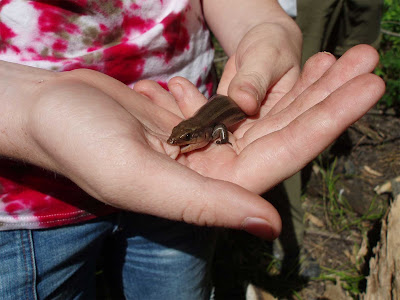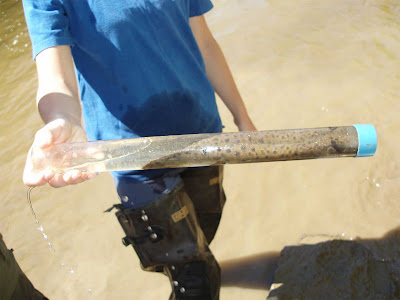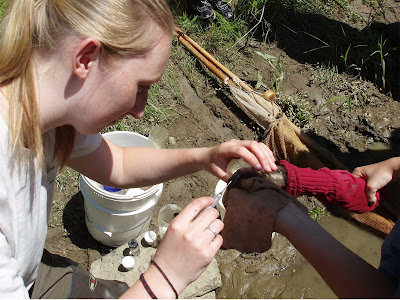Other competing boats are pictured below. People got really creative with their junk!
Launch!
Future Scientists is a Cleveland Museum of Natural History program that blasts teens out into nature. This blog chronicles Future Scientists getting up close and personal with science, falling on their butts, and if you're lucky, wearing floral hats.
 Maggie takes one for the team.
Maggie takes one for the team. This skink had recently lost its tail and is regenerating a new one.
This skink had recently lost its tail and is regenerating a new one. Seining for salamanders.
Seining for salamanders. Checking the haul.
Checking the haul. Dr. Matson shows off a large crayfish.
Dr. Matson shows off a large crayfish. Mudpuppy! The Future Scientists were extremely fortunate to witness the only adult that was found the whole day.
Mudpuppy! The Future Scientists were extremely fortunate to witness the only adult that was found the whole day. Mudpuppy in a tube. A science tube.
Mudpuppy in a tube. A science tube. Injecting a tracking marker into the mudpuppy. Hence the science tube.
Injecting a tracking marker into the mudpuppy. Hence the science tube. One nest of mudpuppy larvae was also found. Here you can see the yolk sac on the ventral side of one of the salamander babies.
One nest of mudpuppy larvae was also found. Here you can see the yolk sac on the ventral side of one of the salamander babies.
 The Future Scientists march across river with gear (rock hammers, goggles, and sandwiches).
The Future Scientists march across river with gear (rock hammers, goggles, and sandwiches). Scopin' out the cliff
Scopin' out the cliff Can you find the fossil?
Can you find the fossil? How about here?
How about here? CMNH Paleontologist and team leader David Chapman explains the difference between hard dusty things that are rocks and hard dusty things that are bone.
CMNH Paleontologist and team leader David Chapman explains the difference between hard dusty things that are rocks and hard dusty things that are bone. Cutting stuff out of the cliff! Jad eats a sandwich.
Cutting stuff out of the cliff! Jad eats a sandwich. Here is a large piece of what turned out to be a Dunkleosteus, one of Cleveland's famous armored fish. Field marks have been placed on the bone for orientation. These pieces will take several weeks to clean. More bone is still in the rock waiting to be harvested.
Here is a large piece of what turned out to be a Dunkleosteus, one of Cleveland's famous armored fish. Field marks have been placed on the bone for orientation. These pieces will take several weeks to clean. More bone is still in the rock waiting to be harvested. Note to future Future Scientists: follow the path that Jeff takes if you'd like to keep your underwear dry.
Note to future Future Scientists: follow the path that Jeff takes if you'd like to keep your underwear dry.
